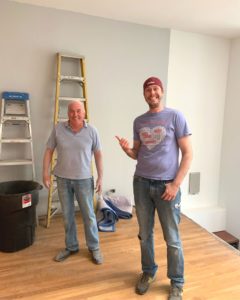A Leadership Secret No One Wants To Admit
Achieving Goals, Confidence, Entrepreneurship, Founding Females, Leadership Coaching, Mindset & Mindfulness, Overcoming Fear, Productivity

We’ve been renovating my condo for a year and a half. It pains me to say this, as my husband and I thought it would be a 3-month job.
We’ve done some of the work ourselves and have hired out a few things to specialists, but the vast majority of the work has been done by our contractor, George. George has been in construction just about his whole life. He has built homes from the ground up. He knows everything. Electrical, plumbing, woodworking, you name it. He’s magical.

Throughout this project, my husband, Ed, has been George’s apprentice. Ed is a pretty handy guy to begin with, but he’s learned so much from working with George. Ed is the most meticulous person you’ll ever meet. If something is a millimeter off, it will drive him insane. He will go nuts over a scratch or a smudge that I can’t even see. He wants everything to be just so.
In front of our house, a few stairs come up from the street to our front porch and front door. Under those stairs is a strange space that doesn’t really have much of a purpose right now. We got the idea to clear it out and make a little wine room with a wet bar. The first step was to build a reservoir for the future sink we’d install, add some plumbing and then pour a concrete floor.
I was honestly in shock watching this process take place. You feel like it should be so official. That there’s a right piece of equipment to use for this reservoir and a right way to attach the piping. Maybe even an Ikea-style kit for putting this thing together. Nope.
They used a bucket. One of those orange 5-gallon buckets you get a home depot. They cut some holes in it to attach some pvc pipes and caulked around the edges to make it waterproof. No offense to Ed and George, but this thing looked like a kid’s science fair project. And not even a good one.
But it worked just fine.
When I took a second to relax the look of shock from my face and reflect a bit, I started to realize that this is what I do at work too. And what I am constantly talking to my team about.
We all want there to be a right way to do things. We want insights to the nth degree before building the marketing campaign. We want 40 years of historical data before building the budget. We want the Ikea kit to help us build the new product. We want the perfect solution to execute or automate the process. But that’s just not reality.
We don’t have the time or money for the level of research we want to do. We’ve only been around for 6 years and each has been so different, so we just don’t have the historicals we’d want. No technology exists to do the thing we’re trying to do, so a frankenstein solution may be our best bet. Just like with building the house, so much comes down to accepting that there’s no perfect solution and having the courage to go for it anyway.
Here’s what I’ve learned from building my business and from George:
1. Rely on principles and frameworks, not memorization.
While the bucket solution may have looked haphazard, it wasn’t a random guess. There needed to be something to collect water, a tube for the water to flow and a mechanism to seal it. Though they creatively put something together with materials we could easily acquire that would meet our needs, there was a thorough understanding of the physics at play and the systems required to meet the goal. I’m not saying you should go making stuff up and entirely winging it. Learn principles, learn history, understand best practices and methodologies. And then use the resources you have to create a solution that works for you and your business. Don’t completely wing it, and also don’t try to memorize exactly what worked someplace else and expect it to work for you too. Understand theory and then adapt.
2. Find people who’ve seen it before and know when to challenge their thinking.
Having guidance and insights from those who have expertise in your area or who have done something similar before is invaluable. They not only can teach you lessons and tactics, they are tremendous at putting things in perspective. When an issue with our construction feels catastrophic, George always has an anecdote that helps right size the problem. Business mentors and coaches can do the same. Be as open minded and curious as possible and soak up as much knowledge as you can. But don’t take every single thing as gospel. Countless times throughout this project, Ed’s newbie status has served him. George will have a tried and true approach, and Ed will ask, “Wait, can’t we just…” Sometimes there will be a reason we can’t, but often Ed’s fresh take will actually find a better, more efficient solution. Regularly seek out the wisdom of others, but also put it through your own critical thinking filter.
3. Get data, proxies and customer insights, but challenge your temptation to want 100% perfection.
We always want to be making data informed decisions. We should absolutely be striving to gather data, conduct research and talk to our customers instead of just hypothesizing. And also, this can be a slippery slope. Especially in cash constrained, quickly moving startups, we don’t have the luxury of taking months and months to gather information before acting. We have to do what we can and then make the best decision possible with the information on hand. I often say it’s easy to disguise procrastination as research. Be honest with yourself about when you truly need more information to be able to move forward and when your fear of being wrong is actually what’s holding you back.
4. Figure out small ways to test and move forward.
While I want you to be assertive, I don’t want you to be foolish. If you want to figure out what’s behind a wall, maybe don’t take a sledgehammer to it. Can you use a tool to gauge what’s back there? Can you cut a small hole and see? The same is true in business. When testing a new product or idea, figure out small, low-risk ways to test your hypotheses before committing to them in full. This will save you a lot of time and money in the long run.
One of the biggest challenges and lessons for Ed throughout our renovation journey is that the expertise and the talent to do anything only gets you so far. Eventually, you just need the confidence to go for it. Ed will want more measurements, more reassurance, more time to think it over before committing to anything. In some ways, this is wise. As they say, “measure twice, cut once.” But at other times, it can be a real struggle as the truth to the matter is, there’s a lot more art and intuition than science to much of this process. George demonstrates this perfectly as he puts thoughtful plans in place and then without delay, whips out the Fein tool and just gets to cutting. He doesn’t belabor decisions, stumble over the what ifs or expect perfection. He just goes for it.
The unfortunate truth to all of this is that there’s no singular right way to do anything. There’s no perfect. There’s no kit. The sooner you realize that we’re all doing a bit of ‘making it up as we go’ the sooner you’ll start building the confidence to do the same.


